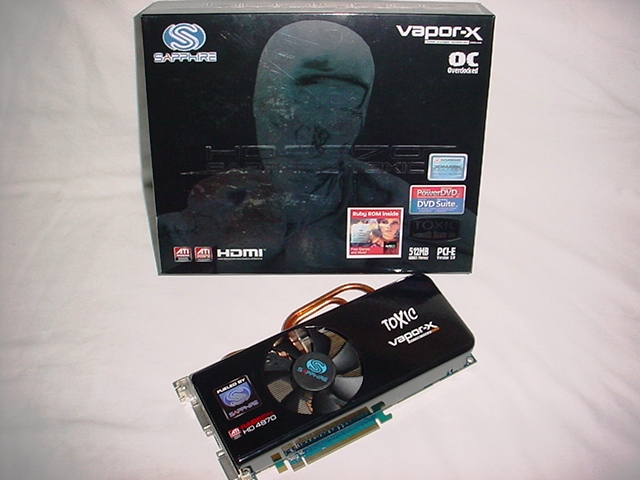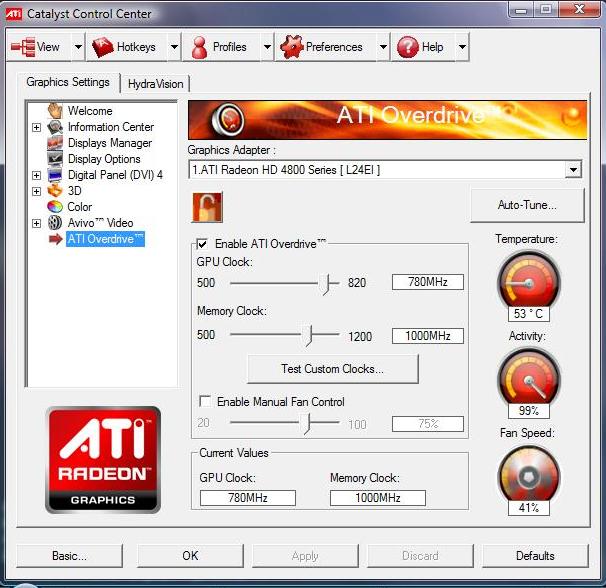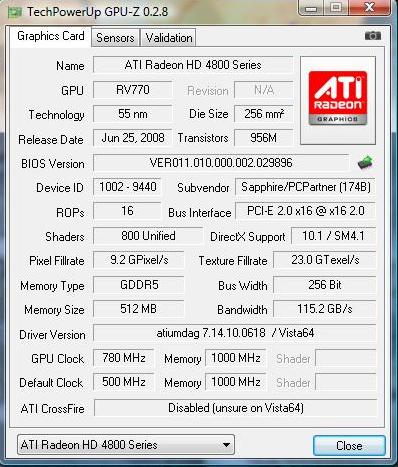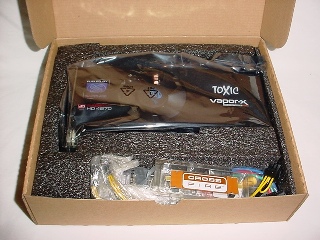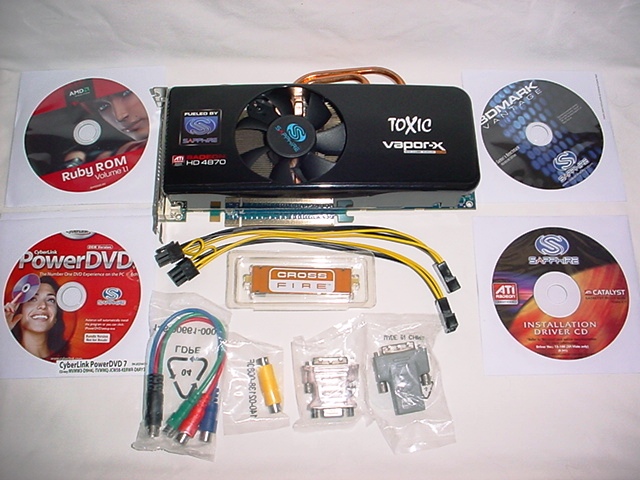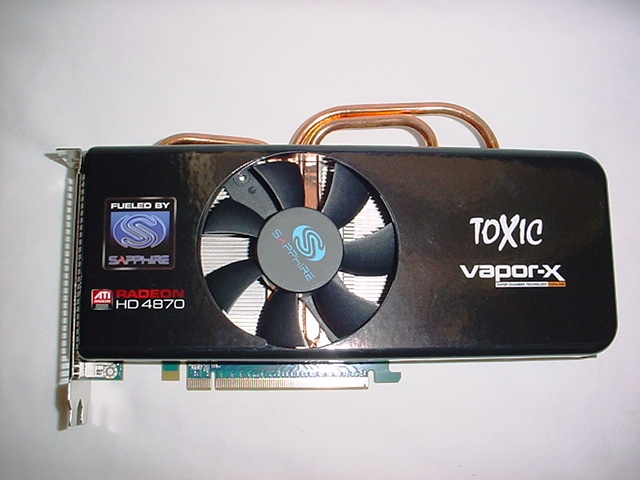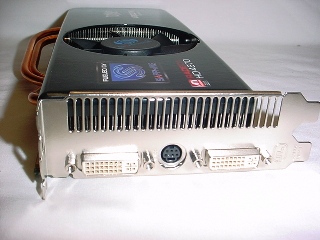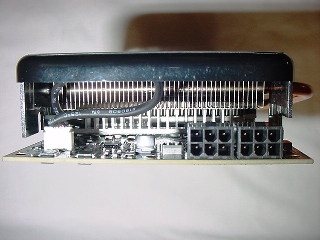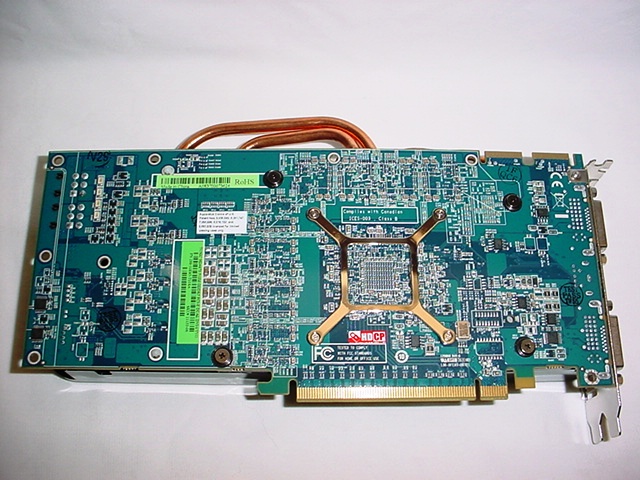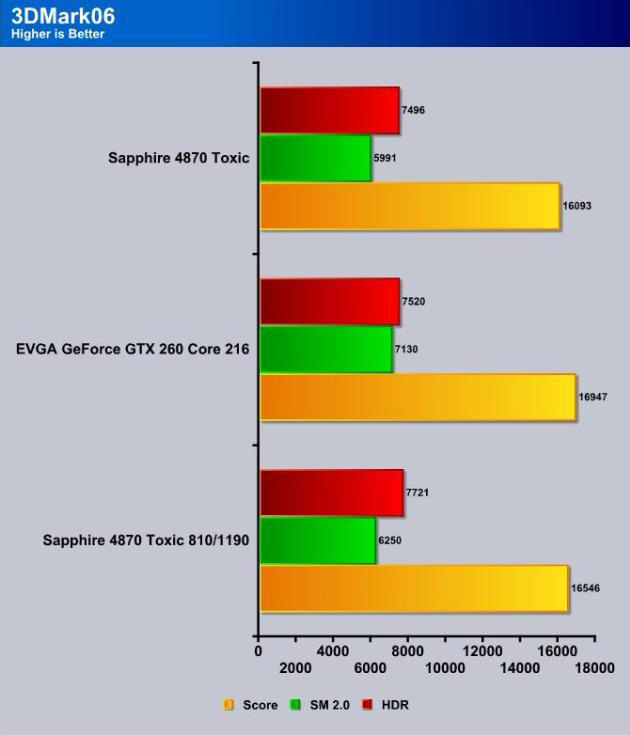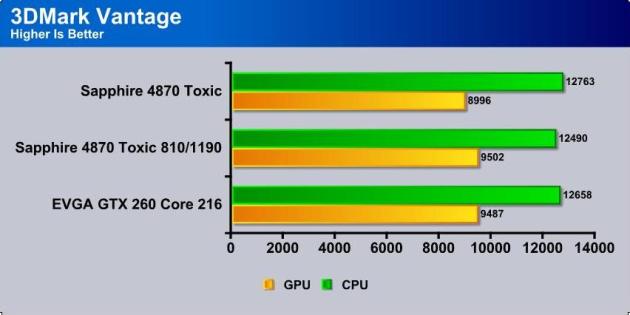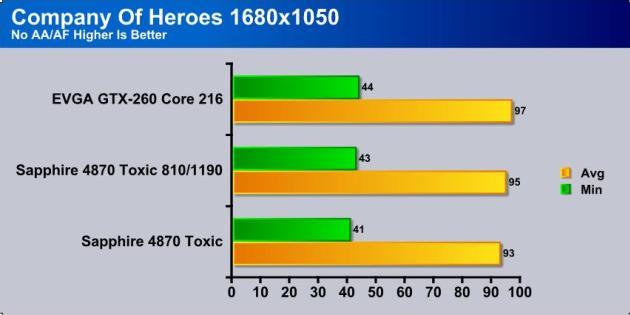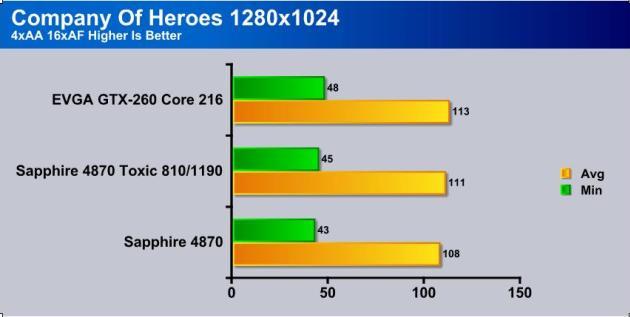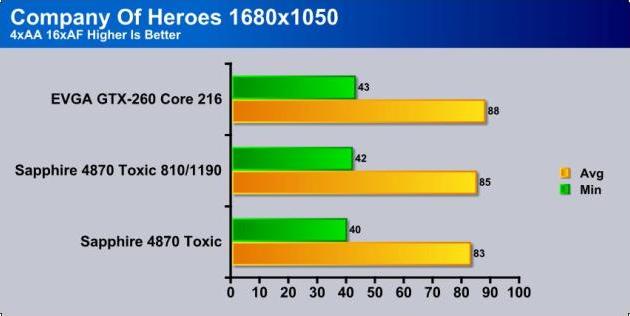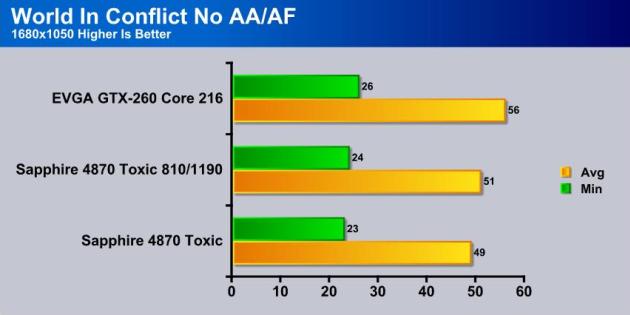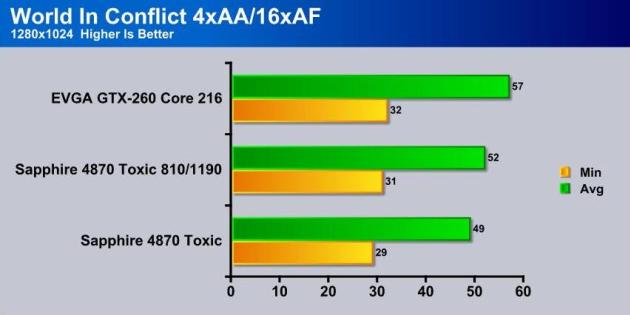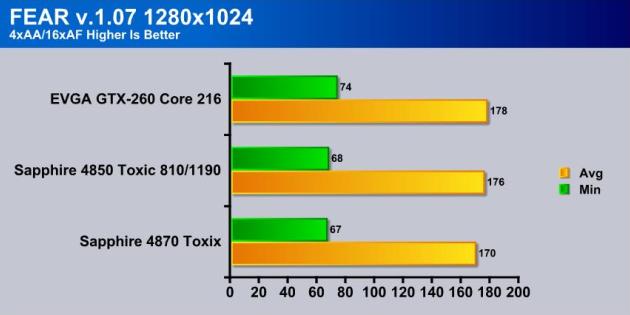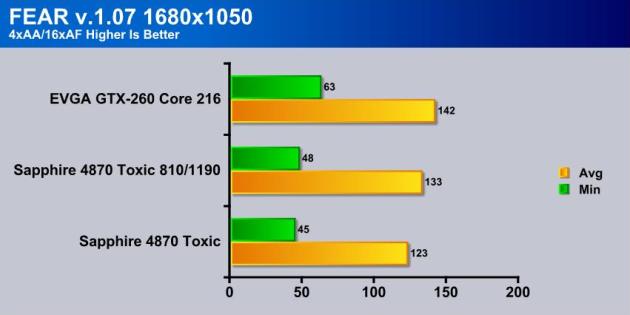The Sapphire Toxic HD4870 is looking to resolve these 2 issues by utilizing their own Vapor-X cooler as well as throwing in a little over clock just for good measure.
INTRODUCTION
With the standard ATi HD4870 being such a huge hit amongst high-end gaming enthusiasts, I’ve been really looking forward to reviewing Sapphire’s Toxic version of the card for my first video card review for Bjorn3D. Even though the standard version has had great success, it wasn’t without a few flaws of its own, the first being that it ran super hot and the second being that the fan was extremely loud.
The Sapphire Toxic HD4870 is looking to resolve these two issues by utilizing their own Vapor-X cooler (Vapor Chamber Technology), as well as throwing in a little over clock just for good measure. Both of these features should help the faint of heart rest a little easier by giving them a better performing card with better cooling, while still maintaining the manufacturer’s warranty.
So let’s get on with things and see just how well the card performs and resolves those few issues.
About Sapphire
Welcome to the SAPPHIRE Family
Pioneers in a new era of how data is displayed and games are played, Sapphire shepherds the performance oriented with ground-breaking solutions to an environment that remains in a constant state of flux and ultimate evolution. For over ten years Sapphire has held true to its unwavering commitment, the commitment to deliver the most feature rich and soundly engineered products. Because of Sapphire’s firm position on achieving excellence with each product that leaves our ISO9001 and ISO14001 certified factories, you can rest assured that your customers will recognize YOUR commitment to selling only the highest of quality components.
Since ATI announced its manufacturing & distribution relationships with ODMs and AiBs in June of 2001, SAPPHIRE has been THE key ATI Graphics Boards Supplier worldwide and now stands poised and ready to capture the mainboard audience of those who seek a stable platform for their mission critical operations.
All SAPPHIRE ATI video boards are manufactured under 100% ATI production criteria including QC and outgoing system. Our monthly video board production capacity can reach a lofty 1.8 million and often topples this landmark figure. Our factory has always been the major manufacturer on ATI boards for most of the top ten tier 1 OEMs worldwide. With this background, you should undoubtedly be guaranteed of the impeccable quality, production capacity and product reliability of all ATI video boards and mainboards from SAPPHIRE. Be they business oriented or something just off center of the crosshairs, Sapphire has a solution for you and we look forward to an exciting and prosperous relationship with you!
FEATURES
The SAPPHIRE HD 4870 TOXIC Edition features the award winning – and SAPPHIRE exclusive – Vapor-X cooler, SAPPHIRE’s implementation of Vapor Chamber Technology (VCT). This advanced cooling solution is used for the core logic, and together with three heatpipes and thermally controlled fan venting outside the case, provides more efficient and quieter cooling than competing solutions for this generation of high performance graphics. The SAPPHIRE HD 4870 TOXIC edition ships overclocked out of the box for an immediate high performance graphical or gaming experience, and the advanced hybrid cooling solution provides enthusiasts with further scope for performance tuning.
- TeraScale Graphics Engine
The powerful new TeraScale graphics engine features deliver high resolutions and fast frame rates. - Enhanced Anti-Aliasing & Anisotropic Filtering
High performance anisotropic filtering and 24x custom filter anti-aliasing (CFAA) smooth jagged edges and create true-to-life graphics, for everything from grass to facial features. - DirectX 10.1
Play today while preparing for tomorrow with state-of-the-art DirectX 10.1 graphics capabilities. - ATI CrossFireX™ Technology
ATI CrossFireX™ technology with up to quad GPU support offers superior scalability so your system is ready to level up when you are. - PCI Express 2.0
- Support for PCI Express 2.0
will prepare you for bandwidth-hungry games and 3D applications. - Power to Spare
This GPU has the brute processing power needed for physics, artificial intelligence, stream computing and ray tracing calculations. - Unified Video Decoder 2
Unified Video Decoder 2 frees up your CPU for other tasks so you get The Ultimate Visual Experience™ for even the most processing-intensive content, including VC-1, H.264 and now MPEG-2. Also, take full advantage of Blu-ray functionality with dual-stream, picture in picture (PIP) capabilities. - Upscale Beyond 1080p
Watch the hottest Blu-ray movies or other HD content at full 1080p display resolution and beyond. - On-chip HDCP
On-chip HDCP (High-Bandwidth Digital Content Protection) makes life easier by allowing you to playback HDCP protected content. - HDMI
Enjoy the latest audio technologies using HDMI with 7.1 digital surround sound support. Also, xvYCC support allows the user to enjoy a wider range of color when connected to a capable HDTV. - ATI PowerPlay™ Technology
ATI PowerPlay™ Technology delivers high performance when needed and conserves power when the demand on the graphics processor is low. - Energy Efficient Manufacturing Process
* Second generation 55nm chip uses the industry’s most energy efficient manufacturing process.
SPECIFICATIONS
Here’s a quick little comparison of how the Toxics specs match up to ATI’s nearest GPU competitors.
| Sapphire 4870 and 4850 Specifications | |||
| GPU | HD Toxic 4870 | HD 4850 | HD 4870 |
| GPU frequency | 780 MHz | 625 MHz | 750 MHz |
| ALU frequency | 780 MHz | 625 MHz | 750 MHz |
| Memory frequency | 1000MHz | 993MHz | 900MHz |
| Memory bus width | 256 bits | 256 bits | 256 bits |
| Memory type | GDDR5 | GDDR3 | GDDR5 |
| Memory quantity | 512 MB | 512 MB | 512 MB |
| Number of ALUs | 800 | 800 | 800 |
| Number of texture units | 40 | 40 | 40 |
| Number of ROPs | 16 | 16 | 16 |
| Shading power | 1.2 TFlop | 1 TFlop | 1.2 TFlops |
| Memory bandwidth | 115.2 GB/s | 31.78 GB/s | 115.2 GB/s |
| Number of transistors | 965 mil | 965 mil | 965 mil |
| Process | 55nm | 55nm | 55nm |
| Die surface area | 260mm² | 260mm² | 260mm² |
| Generation | 2008 | 2008 | 2008 |
| Shader Model supported | 4.1 | 4.1 | 4.1 |
As you can see for the chart, on paper, the Toxic is basicly a Over Clocked HD 4870 card with one major differance, Sapphire’s own Vapor-X cooler. But more on that later on.
Seeing as people are human and humans make mistakes (intentional or other wise), we always like to double check to see if the card’s actual clocks and specs match what the vendor publishes.
As you can see by looking at the screen shots of GPUz and ATI’s Catalyst Control Center, the Toxic’s specs match up perfectly with the vendors specs.
GPU Comparison Table
Here’s a graphic that show some of the hottest GPU’s around so you can get a perspective of the changes from GPU to GPU, ATI to NVIDIA.
| Major GPU Specifications | |||||||
| GPU | HD 3870 X2 | 9800 GX2 | 8800 Ultra | GTX 260 | GTX 280 | HD 4850 | HD 4870 |
| GPU frequency | 825 MHz | 600 MHz | 612 MHz | 576 MHz | 602 MHz | 625 MHz | 750 MHz |
| ALU frequency | 825 MHz | 1500 MHz | 1512 MHz | 1242 MHz | 1296 MHz | 625 MHz | 750 MHz |
| Memory frequency | 900 MHz | 1000 MHz | 1080 MHz | 999 MHz | 1107 MHz | 993MHz | 900MHz |
| Memory bus width | 2×256 bits | 2×256 bits | 384 bits | 448 bits | 512 bits | 256 bits | 256 bits |
| Memory type | GDDR3 | GDDR3 | GDDR3 | GDDR3 | GDDR3 | GDDR3 | GDDR5 |
| Memory quantity | 2 x 512 MB | 2 x 512 MB | 768 MB | 896 MB | 1024 MB | 512 MB | 512 MB |
| Number of ALUs | 640 | 256 | 128 | 192 | 240 | 800 | 800 |
| Number of texture units | 32 | 128 | 32 | 64 | 80 | 40 | 40 |
| Number of ROPs | 32 | 32 | 24 | 28 | 32 | 16 | 16 |
| Shading power | 1 TFlop | 1152 GFlops | 581 GFlops | 715 GFlops | 933 GFlops | 1 TFlop | 1.2 TFlops |
| Memory bandwidth | 115.2 GB/s | 128 GB/s | 103.7 GB/s | 111.9 GB/s | 141.7 GB/s | 31.78 GB/s | 115.2 GB/s |
| Number of transistors | 1334 mil | 1010 mil | 754 mil | 1400 mil | 1400 mil | 965 mil | 965 mil |
| Process | 55nm | 65nm | 80nm | 65nm | 65nm | 55nm | 55nm |
| Die surface area | 2 x 196 mm² | 2 x 324 mm² | 484 mm² | 576 mm² | 576 mm² | 260mm² | 260mm² |
| Generation | 2008 | 2008 | 2007 | 2008 | 2008 | 2008 | 2008 |
| Shader Model supported | 4.0 | 4.0 | 4.0 | 4.0 | 4.0 | 4.1 | 4.1 |
Pictures, Impressions & Bundle
Packaging
I’m not going to waste a lot of time on the packaging, but I will say that the card and included bundle components are extremely well protected which should protect the card during transit and mis-handling.
The exterior of the box is pretty much like most other retailers out there, its covered with nice graphics along with a full lists of features. One thing that I did find a little odd was that although they state that the card is over clocked, they don’t say what it is over clocked to.
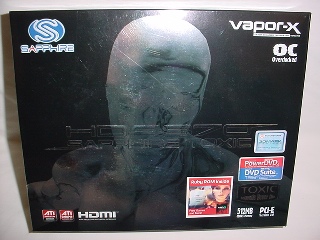 |
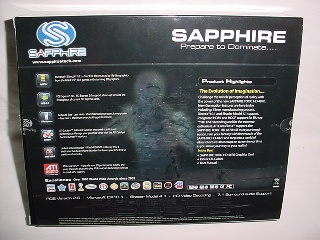 |
Bundle
- 1 – Sapphire 4870 Toxic GPU
- 1 – Manual & Driver Disk
- 1 – Ruby Rom
- 1 – Power DVD
- 1 – DVD Suite
- 1 – 3DMark Vantage W/Key
- 1 – Crossfire Bridge
- 2 – Molex to PCI-E 6 pin adapters
- 1 – DVI to VGA Adapter
- 1 – DVI to HDMI Adapter
- 1 – Component Cable Adapter
- 1 – Svideo to Component Adapter
Impressions
The Toxic itself has a very subdued appearance when compared to most others out there with their flashy graphics and marketing characters pasted all over them. For me, this is a welcome change as most of the stickers come loose over time and are more of a dust collector than anything else. Beside, in most cases, you can’t see the graphics anyways as they are facing the bottom of the chassis.
One thing you’ll notice about the PCB is that it’s Sapphires own make, made in their typical blue color. I’m more of a fan of the standard ATI red, but the blue does look good and it matches my motherboard.
The only thing about the cooler that I’m not completely ecstatic about that it allows some of the hot air to be exhausted into the case at the rear of the card by the two 6 pin PCI-E power connectors.
The cooler itself only cools the GPU and video memory. VRM cooling is taken care of by a separate heat sink pinned to the PCB under the main heat sink and is cooled by the air that is forced through the GPU heat sink that exhausts out the rear of the card.
On the rear of the card you can see that the main cooler is only secured by the screws around the GPU and memory, leaving several mounting holes open. ATI standard coolers are secured using all the fastening points, making for a very flat and secure cooler/card combo. With the Toxics method I noticed that there was a slight bow in the card due to the method of the cooler’s mounting, but the cooler was very secure and it appeared to be making excellent contact with the GPU and memory.
TESTING & METHODOLOGY
The Move To Vista 64
We’ve had to face the reality that Vista is here to stay for a while so we’re doing most of our testing in Vista 64 bit. We’ve held on to the aging Windows XP platform for two years since Vista came out, and Windows 7 is just around the corner so we’re in the process of standardizing to Vista 64 in preparation for Microsoft’s latest and greatest offering.
For testing purposes I’ll be running the Sapphire HD 4870 Toxic against a borrowed EVGA GTX260 Core 216. A huge thanks goes out to my son for letting me use it for a weekend while he was out of town. All of our synthetic and gaming tests will be run at 1280 x 1024 and 1680 X 1050, with no Anti Aliasing or Anisotropic Filtering, and then with 4X Anti Aliasing and 16X Anisotropic Filtering. Each of the tests will be run individually and in succession three times, and an average of the three results calculated and reported. F.E.A.R. benchmarks were also run with soft shadows disabled; all other games with every thing set to max. 3DMark06 and 3DMark Vantage are run at default settings, and just to keep things fair as well,we turned off PhysX for the EVGA 260 Core 216 runs. DirectX 10 games are tested in DirectX 10, and DirectX 9 games are tested in DX9, which should be fully expected.
The Test Rig
| Test Rig “Monster Rig” |
|
| Case Type | Mountain Mods U2 UFO |
| CPU | Intel Q6600 @ stock and 3.6 Voltage 1.45 vcore |
| Motherboard | Gigabyte EP45T Extreme |
| Ram | Patriot DDR3-1600 |
| CPU Cooler |
Watercooling, Loop #1 |
| Hard Drives | Seagate 250 Gig Sata 2 |
| Optical | Lite-On DVD R/W |
| GPU |
Sapphire HD 4870 Toxic, Catalyst 8.10 Drivers EVGA GTX 260 Core 216, 178.24 Geforce Drivers |
| Case Fans | 8 x 120mm fans total |
| Testing PSU | OCZ Game XStream 700w |
| Mouse | Logitech |
| Keyboard | Saitek |
| Just an every day little rig. |
|
Synthetic Benchmarks & Games
| Synthetic Benchmarks & Games | |
| 3DMark06 v. 1.10, Default | |
| 3DMark Vantage, Default | |
| Company of Heroes v. 1.71, All maxed, 4xAA, 16xAF in drivers | |
| Crysis v. 1.2, All max, 0xAA, 0xAF | |
| World in Conflict Demo, All max, 4xAA, 16xAF | |
| F.E.A.R. v 1.08, All max. Soft Shadow Off, 4xAA, 16xAF | |
RESULTS
3DMark06 V. 1.1.0

3DMark06 developed by Futuremark, is a synthetic benchmark used for universal testing of all graphics solutions. 3DMark06 features HDR rendering, complex HDR post processing, dynamic soft shadows for all objects, water shader with HDR refraction, HDR reflection, depth fog and Gerstner wave functions, realistic sky model with cloud blending, and approximately 5.4 million triangles and 8.8 million vertices; to name just a few. The measurement unit “3DMark” is intended to give a normalized mean for comparing different GPU/VPUs. It has been accepted as both a standard and a mandatory benchmark throughout the gaming world for measuring performance.
In 3DMark06 the new generation GTX260 Core 216 bests the Sapphire Toxic HD4870 by almost 1000 point total score where it used to be pretty much even between the GTX 260 and standard HD4870.
3DMark Vantage

For complete information on 3DMark Vantage Please follow this Link: www.futuremark.com/benchmarks/3dmarkvantage/features/
The newest video benchmark from the gang at Futuremark. This utility is still a synthetic benchmark, but one that more closely reflects real world gaming performance. While it is not a perfect replacement for actual game benchmarks, it has its uses. We tested our cards at the ‘Performance’ setting.
Currently, there is a lot of controversy surrounding NVIDIA’s use of a PhysX driver for its 9800 GTX and GTX 200 series cards, thereby putting the ATI brand at a disadvantage. Whereby installing the PyhsX driver, 3DMark Vantage uses the GPU to perform PhysX calculations during a CPU test, and this is where things get a bit gray. If you look at the Driver Approval Policy for 3DMark Vantage it states; “Based on the specification and design of the CPU tests, GPU make, type or driver version may not have a significant effect on the results of either of the CPU tests as indicated in Section 7.3 of the 3DMark Vantage specification and white paper.” Did NVIDIA cheat by having the GPU handle the PhysX calculations or are they perfectly within their right since they own Ageia and all their IP? I think this point will quickly become moot once Futuremark releases an update to the test.
For this test I disabled PhysX on the Nvidia card to take the CPU out of the picture and only show what the video card’s capable of doing. Again, the Nvidia based card had a fairly large lead at stock speeds, but after a nice little overclock on the Sapphire, things are pretty much even. I’m sure that by overclocking the GTX Core 216 it will pull ahead again, but by how much I’m not sure as I wasn’t allowed to OC the borrowed card.
RESULTS
Company Of Heroes v. 1.71

Company of Heroes(COH) is a Real Time Strategy(RTS) game for the PC, announced on April, 2005. It is developed by the Canadian based company Relic Entertainment and published by THQ. COH is an excellent game that is incredibly demanding on system resources thus making it an excellent benchmark. Like F.E.A.R., the game contains an integrated performance test that can be run to determine your system’s performance based on the graphical options you have chosen. It uses the same multi-staged performance ratings as does the F.E.A.R. test. Letting the games benchmark handle the chore takes the human factor out of the equation and ensures that each run of the test is exactly the same producing more reliable results.
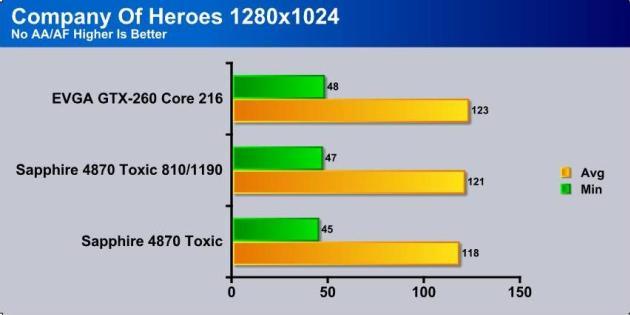
In Company of Heroes all the frame rates stayed within a few frames of each other with the EVGA GTX Core 216 consistently being the leader. Even with the GTX in the lead, both cards delivered great game play and image quality.
WORLD IN CONFLICT DEMO

World in Conflict is a real-time tactical video game developed by the Swedish video game company Massive Entertainment, and published by Sierra Entertainment for Windows PC. The game was released in September of 2007. The game is set in 1989 during the social, political, and economic collapse of the Soviet Union. However, the title postulates an alternate history scenario where the Soviet Union pursued a course of war to remain in power. World in Conflict has superb graphics, is extremely GPU intensive, and has built-in benchmarks. Sounds like benchmark material to us!
If you can call an average of 43 FPS taking a beating in a game, then the Sapphire took a beating at the hands of the GTX 260 Core 216. While the average FPS remained at or above 43 FPS during play, the minimum FPS at some resolutions dropped below 30 FPS causing a little stutter during play.
RESULTS
FEAR V. 1.08

F.E.A.R. (First Encounter Assault Recon) is a first-person shooter game developed by Monolith Productions and released in October, 2005 for Windows. F.E.A.R. is one of the most resource intensive games in the FPS genre of games ever to be released. The game contains an integrated performance test that can be run to determine your system’s performance based on the graphical options you have chosen. The beauty of the performance test is that it gives maximum, average, and minimum frames per second rates. F.E.A.R. is a great benchmark, and one heck of a FPS.
In F.E.A.R., one of my all time favorite games, both cards delivered excellent game play, but again the GTX 260 card had the lead and by almost 20 FPS at 1680×1050 with all the eye candy turned on.
Crysis v. 1.2

Crysis is the most highly anticipated game to hit the market in the last several years. Crysis is based on the CryENGINE™ 2 developed by Crytek. The CryENGINE™ 2 offers real time editing, bump mapping, dynamic lights, network system, integrated physics system, shaders, shadows, and a dynamic music system, just to name a few of the state-of-the-art features that are incorporated into Crysis. As one might expect with this number of features, the game is extremely demanding of system resources, especially the GPU. We expect Crysis to be a primary gaming benchmark for many years to come.
Crysis is another game that gave the Sapphire a little bit trouble. Average frame rates were more than high enough for good game play, but every now and then they would drop down to 24 FPS, causing a intermitted stutter. All in all, still a fun game to play with the Toxic.
Overclocking
Even though the Sapphire HD 4870 Toxic comes pre-overclocked, there’s still a bit of headroom left in the card, which indicates that Sapphire has done a great job binning their GPU’s for use in these cards.
Using the standard ATi Catalyst Control Center’s Overdrive feature I was able to easily push the card from the 780/100 stock clocks all the way to the Overdrive’s max overclock available of 810/1190, and the temps never went above 60°C when running any of the benchmarks.
TEMPERATURES

| GPU Temperatures | |||
| Idle | Load | ||
| EVGA GTX-260Core 216 |
37°C | 66°C | |
| Sapphire Toxic HD 4870 | 45°C | 53°C | |
| Sapphire Toxic HD 4870 810/1190 |
46°C | 58°C | |
The Temperatures at idle were taken after 30 minutes at the desktop with nothing but essential background tasks running. Load temps were taken with 3DMarks06 looping for 30 minutes at a resolution of 1680 x 1050 and default settings. As you can see from the charts and screen charts, Sapphire’s Vapor-X cooler does an excellent job at keeping temps under control, even at max OCs.
Fan noise from the cooler at low loads and general computer usage is very low; with the Toxic installed in my main rig I couldn’t hear the fan at all. When you start putting the Toxic through its paces playing games or running benchmarks, the fan does get noticeably louder, but not to the point of being annoying, which is also a big plus.
Power Consumption
| GPU Power Consumption | |||
| GPU | Idle | Load | |
| EVGA GTX-260 Core 216 |
210 Watts | 301 Watts | |
| Sapphire Toxic HD 4870 | 207 Watts | 299 Watts | |
| Total System Power Consumption | |||
Power Consumption is basically the same for both cards, with the wattage varying only few watts between them. Neither are going to make the Energy Conservation folks all that happy, but hey, they are computer gamers.
CONCLUSION
While the GTX-260 turned in better numbers in basically everything we put it through, during gaming we couldn’t tell the difference between it and the Sapphire HD 4870 Toxic except of one or two exceptions when the Toxic tossed in a little stutter every now and then. The Sapphire HD 4870 Toxic made us just as happy as any of the other tested GPU’s in gaming and surfing. When it comes to video cards, synthetic benchmarks are good for comparison, but living and gaming with a GPU is really where you want satisfaction.
On the technology side of things between ATI and Nvidia based cards, ATI has DX 10.1 and 7.1 surround support along with ATI Stream acceleration which is due to be released next month with their Catalyst™ driver update. Nvidia on the other hand has CUDA and PhysX on their side, so right now we can call that a 50/50 split.
Performance wise, between SLI and Crossfire, the scaling that you get with Crossfire has been better in the past and looks to stay that way for the time being. It runs on motherboards that are a lot less expensive than SLI boards, and is the better performer at a better price point for multiple GPU setups.
Sapphire and ATI have managed to close a significant portion of the performance gap, and they’ve done it at a price that enthusiasts will be glad to see.
The problem with high idle/load temps has been resolved by Sapphire and their Vapor-X cooler and even under full OC load, the card never got over 60°C. The only draw back to the cooler that I saw was that it did discharge some hot air back into the case.
As of this writing, both the Sapphire 4870 Toxic and mid range GTX 260 Core 216 are about the same price (give or take $10). And given that, as a rule, Cross-Fire motherboards are cheaper that their SLI counter parts, building a Cross-Fire setup would be the performance per dollar pick.
Pros:
+Great Performance
+Overclocking Ease
+DX 10.1
+Nice Bundle
+Ease of Install
+Crossfire Ready
+Good Cooling Solution
+Competitive With Competitors
+Price
+Quality Construction
Cons:
–Exhausts Hot Air into Chassis
–No Game in Bundle
–ATI Overdrive Software Limits OC
Now for the hard part. Would I recommend one of these to a family member or friend? I’d have to give that a big yes. If the card would have hit the store shelves a bit earlier on, I think that they would have been a huge hit, but now that the GTX Core 216’s are out and perform slightly better for slightly more cash, it basically comes down to what type of system you are wanting to build. Either way you go, single card or Cross-Fire, the Sapphire HD4870 Toxic will serve you well.
Final Score of 8.5 out of 10 and the Bjorn3D Seal of Approval.
 Bjorn3D.com Bjorn3d.com – Satisfying Your Daily Tech Cravings Since 1996
Bjorn3D.com Bjorn3d.com – Satisfying Your Daily Tech Cravings Since 1996
